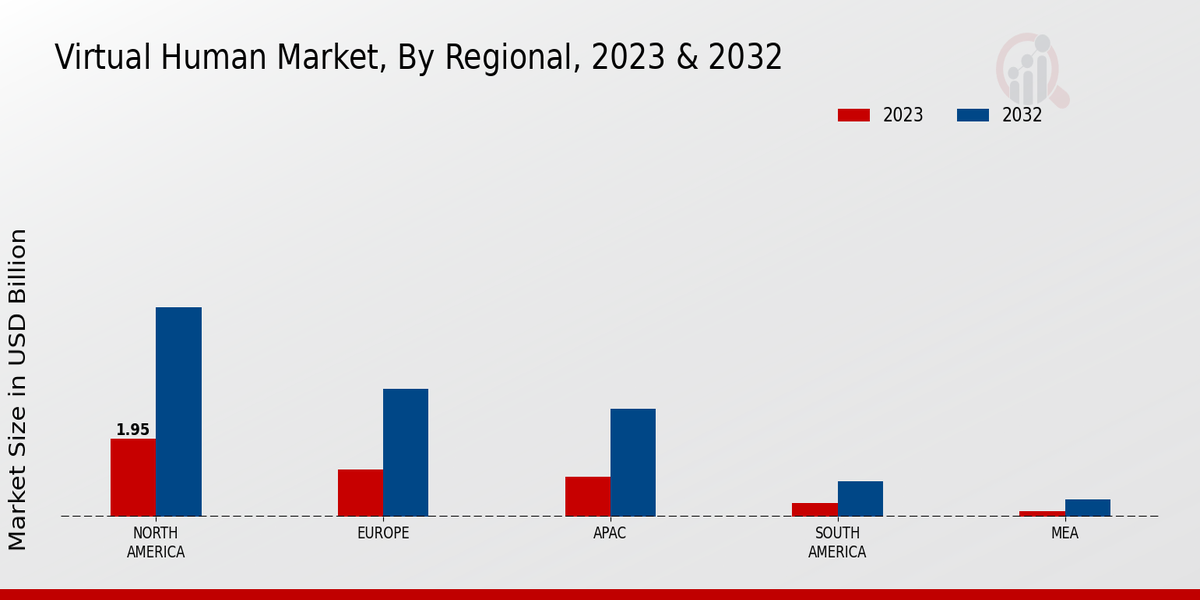Market Growth Projections
The Global Virtual Human Market Industry is poised for substantial growth, with projections indicating a market value of 5.79 USD Billion in 2024 and an anticipated increase to 19.4 USD Billion by 2035. This growth trajectory reflects a compound annual growth rate (CAGR) of 11.63% from 2025 to 2035, underscoring the increasing relevance of virtual humans across various sectors. The market's expansion is driven by technological advancements, rising demand for automation, and the growing acceptance of virtual humans in social interactions. As industries continue to explore innovative applications, the Global Virtual Human Market is likely to flourish in the coming years.
Technological Advancements
The Global Virtual Human Market Industry is experiencing rapid growth due to continuous technological advancements in artificial intelligence and machine learning. These technologies enhance the capabilities of virtual humans, enabling them to interact more naturally and effectively with users. For instance, advancements in natural language processing allow virtual humans to understand and respond to human emotions and intentions. As a result, the market is projected to reach 5.79 USD Billion in 2024, with expectations of further growth as these technologies evolve. The integration of virtual humans into various sectors, including healthcare and customer service, illustrates their increasing relevance and utility.
Rising Demand for Automation
The Global Virtual Human Market Industry is driven by a rising demand for automation across various sectors. Businesses are increasingly adopting virtual humans to streamline operations, enhance customer engagement, and reduce operational costs. For example, companies in the retail sector utilize virtual assistants to handle customer inquiries, thereby improving service efficiency. This trend is expected to contribute to the market's growth, with projections indicating a value of 19.4 USD Billion by 2035. The shift towards automation not only improves productivity but also allows human employees to focus on more complex tasks, thereby enhancing overall organizational performance.
Increased Investment in AI Technologies
Investment in artificial intelligence technologies is a significant driver of the Global Virtual Human Market Industry. Governments and private entities are allocating substantial resources to develop AI-driven solutions, which include virtual humans. This influx of capital fosters innovation and accelerates the development of more sophisticated virtual human applications. For instance, the healthcare sector is leveraging virtual humans for telemedicine and patient interaction, enhancing service delivery. As the market matures, the compound annual growth rate (CAGR) is projected at 11.63% from 2025 to 2035, indicating a robust growth trajectory fueled by ongoing investments in AI.
Growing Acceptance in Social Interactions
The Global Virtual Human Market Industry is witnessing growing acceptance of virtual humans in social interactions. As society becomes more accustomed to digital communication, virtual humans are increasingly utilized in social media, gaming, and entertainment. Their ability to create engaging and interactive experiences resonates with users, leading to higher adoption rates. For instance, virtual influencers are gaining popularity on platforms like Instagram, where they engage with audiences in a relatable manner. This trend suggests a promising future for virtual humans, as their integration into everyday social interactions continues to expand, further solidifying their role in the digital landscape.
Emerging Applications in Diverse Industries
The Global Virtual Human Market Industry is expanding due to emerging applications across diverse industries. Virtual humans are being deployed in sectors such as education, training, and marketing, showcasing their versatility. For example, educational institutions are utilizing virtual tutors to provide personalized learning experiences, while marketing campaigns increasingly feature virtual brand ambassadors. This diversification of applications not only enhances the market's appeal but also drives innovation as industries explore new ways to leverage virtual human technology. The potential for growth in these areas indicates a dynamic future for the Global Virtual Human Market.
















